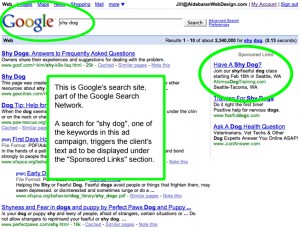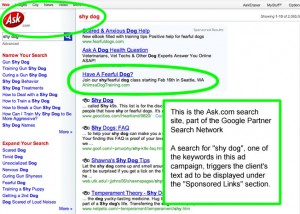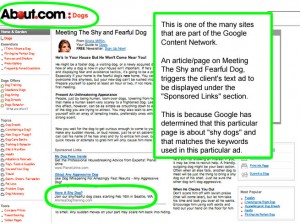AdWords Search Network vs Content Network
January 12th, 2008I frequently do Google AdWords consulting for my small business clients, and they often express confusion in understanding the difference between enabling the search network and the content network. Since this is one of the many choices that they must make, I wanted to try and clarify the differences with actual examples.
When you set up a new Google AdWords campaign, one of the choices you will have to make is whether to have this particular campaign run on the “search network” or the “content network” or both. These two networks are quite different, and your click through rate (CTR) will also be impacted depending on your selection. (CTR is the number of clicks divided by number of impressions, impressions being the number of times your ad is shown).
Search Network: Google Search and Google Partner Search
The “search network” is made up of Google’s search engines (Google.com) and many other search engines that Google considers partners. Don’t worry about who makes up the Google partners, but rather what’s important is that these are all search engines. This means that the people who will see your ad are all in the process of searching, looking for some solution to their problem, or a product or service to buy.
Here are some screenshots to show you examples of ads that are running on the Google Search and Google Partner Search. The ad is for a Shy Dog class run by Ahimsa Dog Training.
Here’s the ad on Google’s regular search site:
And here’s the same ad running on one of Google’s search partners, Ask.com.
Again, keep in mind that when your ad runs on the search network, people who see your ad are actively searching – therefore the CTR for these ads are generally higher than they are for the content network, which I’ll cover next.
The Content Network
The content network is a vast network of websites that have content, all kinds of content. Google is smart enough to know what content is on each page and will show your ad on a page that has relevant content. So in this example, if a web page has content that’s related to the keywords in ad, in this case shy dogs, Google will show ads that are relevant to shy dogs, such as Ahimsa’s Shy Dog ad.
The first example is from an article called “Rehabilitating Shy Dogs” on the website Suite101.com. Take a look at the screenshot:
Here’s another example from About.com which had an article entitled “Meeting the Shy and Fearful Dog”:
Note the differences from the search network. People are actively reading an article on a topic and may click on your ad, but you can see how the probability of someone clicking on an ad under these circumstances might be very different from someone who is searching. This is why the CTR on the content network is generally lower than on the search network.
Now, this doesn’t mean that one network is “better” than another. In general when I start a new campaign, I’ll advise folks to only enable the search network until they have a good feel for how the whole system works. You will rack up many, many impressions on the content network before you get any clicks, and since we’re testing out different keywords and different ads, I want clients to be able to get clicks quickly.
I’ve read that people might use the content network when they’re trying to get brand recognition or name recognition – getting clicks might not be the primary goal. Since I’m not an advertising expert, I’ll leave that theory to them – but suffice to say that you’ll get many, many, many impressions on the content network before you get clicks. So don’t be surprised if that happens.
I’ve also read that folks believe the content network with is more prone to click fraud. This is because in the content network are these pages that are known as “made for adsense” pages – pages that have virtually no real content.
In sum, if you’re new to Ad Words and starting a new campaign, turn on the search network and turn off the content network. Get a good feel for how the system works and which keywords really do bring you the most clicks for your money before turning on the content network. And always, always track your website traffic so that you can compare the number of clicks that you’re paying for versus what you’re getting.
Jill--------------
J. Olkoski
Aldebaran Web Design, Seattle
Jill Olkoski has a BS in Engineering, a BS in Computer Science and an MA in Clinical Psychology. She delights in using her advanced technical and psychological skills to help small business owners develop cost-effective and successful websites.





September 17th, 2009 at 12:11 am
great article thank you! Do you know where to compare adword traffic from content and search engines in analytics? Cant seem to find it anywhere…
September 25th, 2009 at 9:17 am
Hi Justy,
I don’t recall where to find this comparison – but perhaps if you send an email to the folks at Google AdWords, they can assist. I’ve had good luck with that method.
July 14th, 2010 at 6:00 pm
Great article. The only additional thing to consider here would be that high impressions with few clicks will lower your quality score and increase your cost of advertising and affect ad position. This is a fair assessment of content vs. search network. Thanks for the heads up!
October 20th, 2011 at 5:19 pm
I find that the search network gets 10x more clicks than the content network.